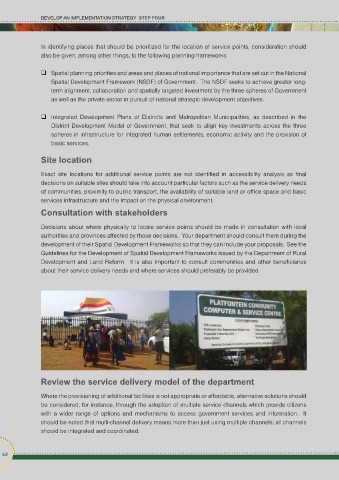Page 68 - C:\Users\Evans Moetji\Desktop\DPSA Guideline Digital Flipbook\
P. 68
DEVELOP AN IMPLEMENTATION STRATEGY STEP FOUR
In identifying places that should be prioritized for the location of service points, consideration should
also be given, among other things, to the following planning frameworks:
Spatial planning priorities and areas and places of national importance that are set out in the National
Spatial Development Framework (NSDF) of Government. The NSDF seeks to achieve greater long-
term alignment, collaboration and spatially targeted investment by the three spheres of Government
as well as the private sector in pursuit of national strategic development objectives.
Integrated Development Plans of Districts and Metropolitan Municipalities, as described in the
District Development Model of Government, that seek to align key investments across the three
spheres in infrastructure for integrated human settlements, economic activity and the provision of
basic services.
Site location
Exact site locations for additional service points are not identified in accessibility analysis as final
decisions on suitable sites should take into account particular factors such as the service delivery needs
of communities, proximity to public transport, the availability of suitable land or office space and basic
services infrastructure and the impact on the physical environment.
Consultation with stakeholders
Decisions about where physically to locate service points should be made in consultation with local
authorities and provinces affected by those decisions. Your department should consult them during the
development of their Spatial Development Frameworks so that they can include your proposals. See the
Guidelines for the Development of Spatial Development Frameworks issued by the Department of Rural
Development and Land Reform. It is also important to consult communities and other beneficiaries
about their service delivery needs and where services should preferably be provided.
Review the service delivery model of the department
Where the provisioning of additional facilities is not appropriate or affordable, alternative solutions should
be considered, for instance, through the adoption of multiple service channels which provide citizens
with a wider range of options and mechanisms to access government services and information. It
should be noted that multi-channel delivery means more than just using multiple channels; all channels
should be integrated and coordinated.
63 63

